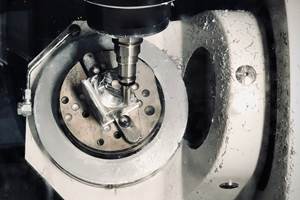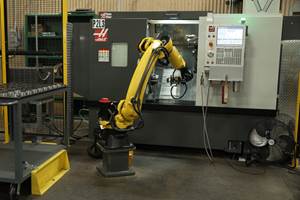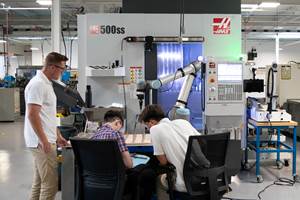Standard Software Addresses Common Machining Challenges
These low-cost VMCs come standard with a number of software features that enable them to compensate for machining’s inherent physical and thermal challenges.
Share





Machine tools fight physics as they cut. Each encounters centrifugal force, thermal expansion and variances in tool load that can adversely affect machining accuracy. According to Hwacheon, shops generally overcome these hurdles either by buying optional tooling, spindle or software components, or by purchasing a costly machine that already has features built-in to address those issues.
However, Hwacheon has made a concerted effort to offer high-end machining capabilities in line with a job shop’s pocketbook. Introduced at IMTS 2010, the Korean builder’s low-cost Vesta line of VMCs comes standard with a number of software features that enable them to compensate for machining’s inherent physical and thermal challenges. These features provide:
•Spindle displacement control—This addresses two conditions: centrifugal force and spindle thermal growth. Centrifugal force at high spindle speeds causes the spindle taper to expand. This tends to pull the toolholder higher up into the spindle, causing variation in a tool’s Z-axis length. Although this spindle taper expansion isn’t managed physically, the Vesta’s Hwacheon Spindle Displacement Control (HSDC) can compensate for Z-axis variation by adjusting the Z-axis servomotor to change the tool’s longitudinal position.
Similarly, thermal growth can adversely affect part accuracy because tools grow longitudinally as spindle temperature increases. This growth varies depending on the rotational speed, tool mass and spindle characteristics. The HSDC compensates for varying tool growth using sensors located along the length of the spindle that continuously monitor spindle temperature. Plus, a cooling jacket installed on the motor both controls heat and keeps the temperature of internal spindle components uniform. This jacket works in conjunction with a fan-cooled chiller unit that cycles according to the spindle temperature.
•Frame displacement control—Thermal growth can also cause a machine’s frame to move, meaning operators must make offsets so that parts are machined to tolerance. This can lead to downtime and potential scrap if there is no automatic means to control these offsets. The Hwacheon Frame Displacement Control (HFDC) receives feedback from temperature sensors strategically placed on each Vesta machine’s casting. Finite Element Analysis design combined with a set of algorithms allows the HFDC to automatically offset the machine’s axis motors to compensate for this thermal growth.
•Efficient Contour Control—It can be difficult to achieve high speed and high precision simultaneously because the precision with which a cutter follows the programmed tool path can vary. The Hwacheon Efficient Contour Control (HECC) effectively manages machining time during chip generation by optimizing the cutting parameters according to the requisite cutting speed and accuracy.
•Tool Load Detection—A dull tool requires higher power to drill a hole or mill a surface. Defects in workpiece material can cause higher tool loading, too. Plus, irregularly shaped workpieces can extend cycle time and reduce tool life because variances in part depth can cause higher loads. These scenarios can result in decreased dimensional accuracy, poor surface finish, tool breakage or even workpiece damage.
The Hwacheon Tool Load Detection (HTLD) feature actively monitors the load on the spindle motor to avoid these conditions. HTLD enables the machine operator to set load thresholds and other parameters that, when exceeded, will trigger an alarm and stop the machine. The machine’s control system also automatically adjusts the feed rate while measuring the load on a spindle motor. It will reduce feed rates when a tool encounters material hard spots or heavier cutting depths and increase the feed rate in soft areas, voids or shallower cutting depths.
Related Content
How to Successfully Adopt Five-Axis Machining
While there are many changes to adopt when moving to five-axis, they all compliment the overall goal of better parts through less operations.
Read MoreHow to Determine the Currently Active Work Offset Number
Determining the currently active work offset number is practical when the program zero point is changing between workpieces in a production run.
Read MoreWhich Approach to Automation Fits Your CNC Machine Tool?
Choosing the right automation to pair with a CNC machine tool cell means weighing various factors, as this fabrication business has learned well.
Read MoreCNC Machine Shop Honored for Automation, Machine Monitoring
From cobots to machine monitoring, this Top Shop honoree shows that machining technology is about more than the machine tool.
Read MoreRead Next
AMRs Are Moving Into Manufacturing: 4 Considerations for Implementation
AMRs can provide a flexible, easy-to-use automation platform so long as manufacturers choose a suitable task and prepare their facilities.
Read MoreMachine Shop MBA
Making Chips and ¸ßĹâÂĘÁůşĎ˛Ę are teaming up for a new podcast series called Machine Shop MBA—designed to help manufacturers measure their success against the industry’s best. Through the lens of the Top Shops benchmarking program, the series explores the KPIs that set high-performing shops apart, from machine utilization and first-pass yield to employee engagement and revenue per employee.
Read More





















